#west african dish
Explore tagged Tumblr posts
Text
Groundnut soup
Groundnut soup is a West African dish that is typically made with peanut butter as its main ingredient. It is a thick and hearty soup that is often served with rice or fufu, a starchy accompaniment. Groundnut soup is known for its rich and nutty flavor, and it is often seasoned with a variety of herbs and spices. It is a popular dish in countries such as Ghana, Nigeria, and Senegal, and is often…

View On WordPress
0 notes
Text



Ackee and saltfish is the Jamaican national dish prepared with sautéed ackee and salted codfish.

The ackee fruit (Blighia sapida) is the national fruit of Jamaica. It was brought to the Caribbean from Ghana before 1725 as 'Ackee' or 'Aki', another name for the Akan people, Akyem. The fruit's scientific name honours Captain William Bligh who took the fruit from Jamaica to the Royal Botanic Gardens in Kew, England in 1793 and introduced it to science. Because parts of the fruit are toxic, such as the arils prior to the opening of the husk at the ripening stage, there are shipping restrictions when being imported to countries such as the United States. Salted codfish, on the other hand, was introduced to Jamaica for enslaved people as a long-lasting and inexpensive protein source. In west Africa, ackee is mainly used as medicine or an ingredient for soap and is not consumed as food

#african#afrakan#kemetic dreams#africans#brownskin#brown skin#afrakans#african culture#jamacia#Jamaican national dish#ackee#ackee and saltfish#captain william#west africa#kew
7 notes
·
View notes
Text

AFANG - Tripe Stew from West Africa
Without any iota of doubt, soups are a big part of the African cuisine, in fact, it is wise to say that African soups are the main attraction of cuisine in the continent.
African soups can be made with a combination of vegetables and ingredients that are native to the countries where they are most eaten.
Very many African soups are usually eaten with other food staples such as rice, fufu, banku, sadza, garri, pounded yam, and so on.
Below are some of our favorite soups from different African countries.
1. Okra soup

Okra soup is a popular west African dish with okra as its main ingredient. Although this deliciously slimy dish can be cooked with the local palm oil, it is also a good choice for people who are wary of adding oil to their soups.
2. Abenkwan
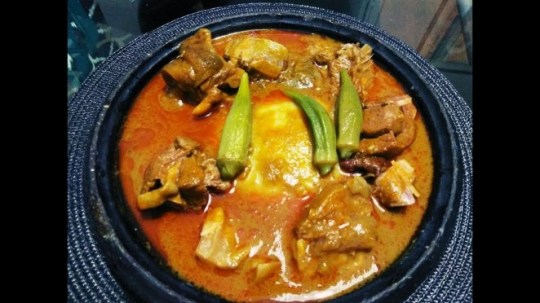
Abenkwan is a Ghanaian soup made from the nuts of the palm tree. The pulp is extracted from the palm fruits and cooked in combination with spices and preferred meat of choice.
Abenkwan has an earthy flavor thanks to the addition of the palm fruit pulp (which is different from the palm oil). Serve warm with rice balls or Kokonte and you will be satisfied to the moons and back.
3. Muriwo na Nyama
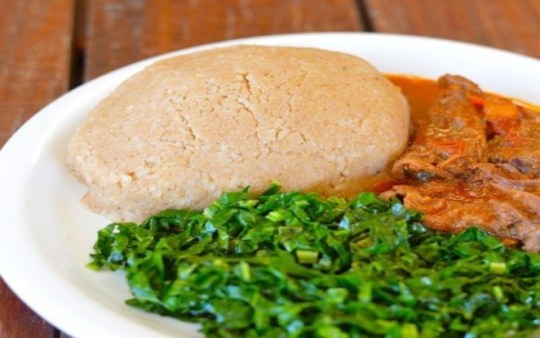
Muriwo na nyama is also known as leafy-beefy or high fields stew. It is native to Zimbabwe, highly nutritious and cn be eaten with sadza.
4. Pepper soup
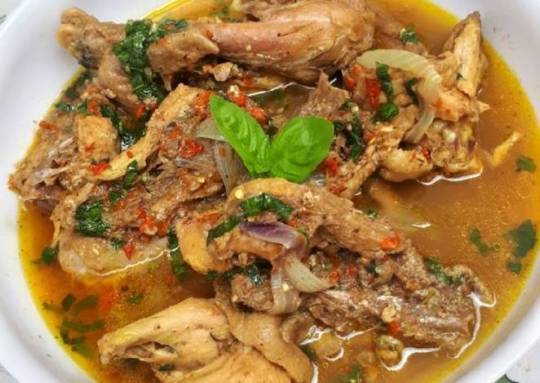
Pepper soup is a spicy African soup that will make your taste buds tingle with excitement. The soup is gotten from the stock of the meat or fish used. It is also spiced with local ingredients, giving it a tantalizing aroma and taste that will make you hungry even if you just had dinner.
For the best experience, have your pepper soup hot–not scalding hot of course– and thank us later.
5. Agushie/Egusi soup

Agushie (Ghana)/Egusi(Nigeria) is a delicious soup cooked with shelled melon seeds. The method of preparation might differ across the different regions in which this soup is eaten but it ultimately includes the addition of leafy greens, seasoning and palm oil. In Nigeria, its best served with freshly pounded yam.
6. Domoda

Domoda is the Gambia’s national dish, second only to Yassa. It is a yummy soup cooked with unsweetened peanut butter. It might also contain sweet potatoes. Domoda is better enjoyed with rice.
7. Afang
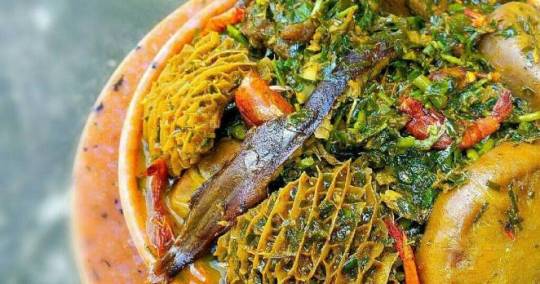
Afang is a delightful and satisfying soup from southern Nigeria. It is similar to the eru soup in Cameroon. They both make use of the afang/okazi leaves. However, the afang leaves are pounded and used in addition to water leaf. Afang soup is rich in deliciousness and best served hot with fufu and lots of meat.
8. Ndole
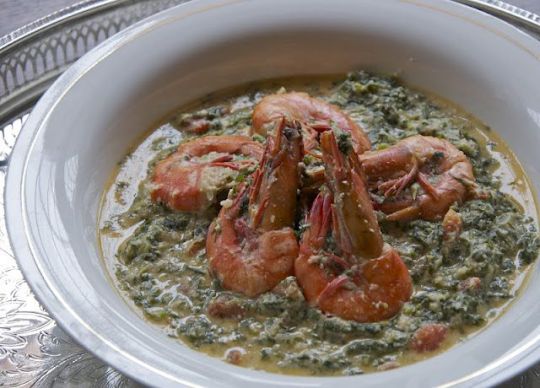
Ndole is another leafy vegetable soup with its home in Cameroon. It is often considered the national dish of the central African country. It’s a creamy and nutritious soup cooked with pureed peanuts and bitter leaf.
9. Afia efere/Ofe nsala
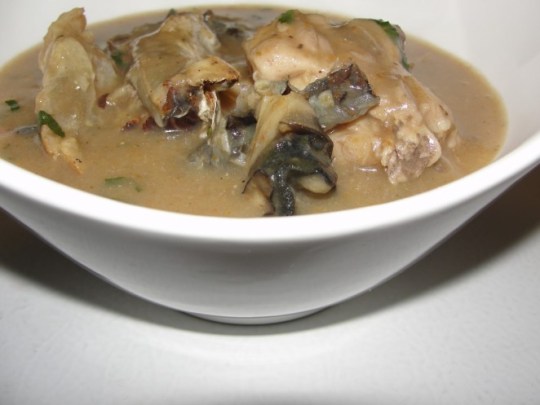
In the Nigerian local languages of Annang and Igbo, afia efere and ofe nsala respectively mean ‘white soup’ in English. Technically, this mouth-watering spicy soup should be called ‘brown soup’ but where’s the fun in that? It is apparently called ‘white’ for the lack of palm oil use.
10. Ewedu Soup
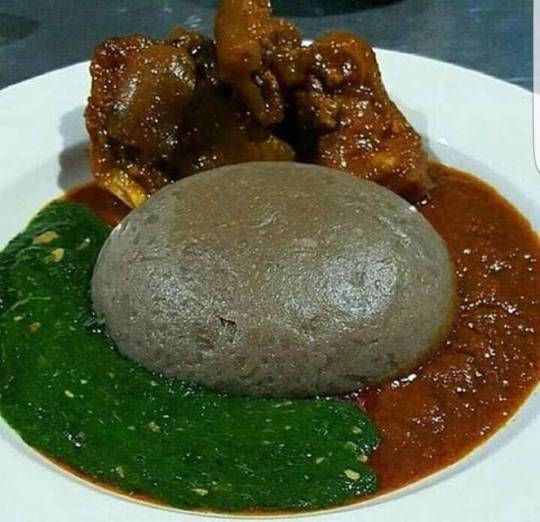
Ewedu is a Nigerian soup which is popular among the Yorubas. It’s a leafy vegetable soup but unlike other African soups, the greens (jute leaves) are pureed and cooked with nothing more than salt, locust beans and often potash.
It is usually served in addition to peppered stews (as pictured above) or gbegiri (beans soup). Yorubas love to eat this with amala, a starchy swallow made from yam peels and sometimes plantains.
#west african food#cooking#african food#stews#soups#main dish#african#Top 10 Delicious African Soups That Will Make You Salivate And Where They Are Best Made
87 notes
·
View notes
Text
everybody stop this madness hobie (spidey punk) is not eating fucking beans on toast HE IS EATING FOOD WITH FLAVOUR!!!!!!!!!!!!!!!!!!!!!!!!
#HE IS EATING BUN AND CHEESE FOR BREAKFAST OR MAYBE YAM AND SCRAMBLED EGGS NOT NO FUCKING BEANS ON TOAST#<- before u start making some british jokes these are both west African and jamaican dishes so hush your mouth NEOW#everybody itching to make british jokes for hobie but they're leaving out that he is not eating food that is boiled water flavoured#he may be poor and homeless but he knows flavourful food. he is not like these white brits u keep making fun of!
34 notes
·
View notes
Text

The Sunshine Sisters Of Africa - African Dish (1984) [FLAC]
- Contact me for digital exchange!
#The Sunshine Sisters Of Africa - African Dish (1984) [FLAC]Rare Afro Exchange#Funk#Disco#Reggae#Boogie#Highlife#Music#West Africa#South Africa#Nigeria#Ghana#Ivory Coast#Togo#Benin#Cameroon#Antilles
0 notes
Text
The Emblematic Soul Disc Dish Pendant of Asante Soul Priests in Ghana, Africa
The Soul Disc Dish Pendant holds a significant place in the cultural and spiritual legacy of the Asante people in Ghana, Africa. This striking piece of jewelry stands as a testament to the rich traditions and beliefs of the Asante community, particularly as it pertains to the revered soul priests and their connection to the spiritual realm. Crafted with meticulous attention to detail, the Soul…

View On WordPress
#African Art#African artifact#African History#African Pendant#Art#Artifacts#Asante history#Ghana History#Soul Disc Dish#West African#West African history
0 notes
Photo

Stews - Jollof Rice with Beef This simple and delectable recipe for jollof rice, a hearty Ghanaian dish, involves stewing jasmine rice in a spiced tomato and meat sauce.
0 notes
Text
Ugh I miss home
0 notes
Text
In the current epidemic of rich Western women who cannot “choose” to eat, we see the continuation of an older, poorer tradition of women’s relation to food. Modern Western female dieting descends from a long history. Women have always had to eat differently from men: less and worse. In Hellenistic Rome, reports classicist Sarah B. Pomeroy, boys were rationed sixteen measures of meal to twelve measures allotted to girls. In medieval France, according to historian John Boswell, women received two thirds of the grain allocated to men. Throughout history, when there is only so much to eat, women get little, or none: A common explanation among anthropologists for female infanticide is that food shortage provokes it. According to UN publications, where hunger goes, women meet it first: In Bangladesh and Botswana, female infants die more frequently than male, and girls are more often malnourished, because they are given smaller portions. In Turkey, India, Pakistan, North Africa, and the Middle East, men get the lion’s share of what food there is, regardless of women’s caloric needs. “It is not the caloric value of work which is represented in the patterns of food consumption” of men in relation to women in North Africa, “nor is it a question of physiological needs…. Rather these patterns tend to guarantee priority rights to the ‘important’ members of society, that is, adult men.” In Morocco, if women are guests, “they will swear they have eaten already” or that they are not hungry. “Small girls soon learn to offer their share to visitors, to refuse meat and deny hunger.” A North African woman described by anthropologist Vanessa Mahler assured her fellow diners that “she preferred bones to meat.” Men, however, Mahler reports, “are supposed to be exempt from facing scarcity which is shared out among women and children.”
“Third World countries provide examples of undernourished female and well-nourished male children, where what food there is goes to the boys of the family,” a UN report testifies. Two thirds of women in Asia, half of all women in Africa, and a sixth of Latin American women are anemic—through lack of food. Fifty percent more Nepali women than men go blind from lack of food. Cross-culturally, men receive hot meals, more protein, and the first helpings of a dish, while women eat the cooling leftovers, often having to use deceit and cunning to get enough to eat. “Moreover, what food they do receive is consistently less nutritious.”
This pattern is not restricted to the Third World: Most Western women alive today can recall versions of it at their mothers’ or grandmothers’ table: British miners’ wives eating the grease-soaked bread left over after their husbands had eaten the meat; Italian and Jewish wives taking the part of the bird no one else would want.
These patterns of behavior are standard in the affluent West today, perpetuated by the culture of female caloric self-deprivation. A generation ago, the justification for this traditional apportioning shifted: Women still went without, ate leftovers, hoarded food, used deceit to get it—but blamed themselves. Our mothers still exiled themselves from the family circle that was eating cake with silver cutlery off Wedgwood china, and we would come upon them in the kitchen, furtively devouring the remains. The traditional pattern was cloaked in modern shame, but otherwise changed little. Weight control became its rationale once natural inferiority went out of fashion.
— Naomi Wolf (1990) The Beauty Myth
#hunger#long post#naomi wolf#the beauty myth#radblr#radfem#radical feminism#radfem safe#radical feminist safe#!!!
821 notes
·
View notes
Note
as a non american i have to ask what american cultural food is there.. i cant think of anything
there is creole cuisine of the usamerican south that is a blend of indigenous, west african, french, and spanish food (side note creole cuisine is not a monolith, there is creole food basically everywhere that was colonized & had a large population of enslaved people)
there is also cajun, which is specifically from the southern state louisiana, it has a lot of similarities to creole cuisine as it is influenced by the acadian french, west african people, and the spanish (ppl often use creole and cajun terms interchangeably but they are distinct)
the food of hawai'i which started as indigenous food of the islands and the goods that was traded within the polynisian triangle, but because of colonization has influences from the US military (spam being a notable case of this), portugal, japan, and china
there is south western cuisine (and the many subtypes) that blends indigenous (pueblo, O'odham, and more) colonial spanish, and mormon foods! this food was shaped by the jobs the people of this area held - lots of influence from cowboys/vaqueros and ranch workers. each southern state has a specific twist!
soul food is based on what enslaved people cooked for themselves, actually a lot of cultural knowledge was passed down & preserved in soul food! lots of southern dishes are based on, inspired by, or straight up stolen from soul cuisine. during the 60s soul food restaurants were important places for organizing! there are also several different styles of bbq
midwestern cuisine is based on various european foods (mainly eastern europen but not solely) and also the agriculture of the area (lots of wheat & pork).
since ~1850 there has been chinese american cuisine! fortune cookies, crab rangoon, general tsos chicken and beef & broccoli are all chinese american.
italian american food uses more cheese & milk than italian food. there are also differences in how we serve pizza
the hot dog is a classic american food! in germany frankfurters weren't served on buns. again most major cities of the us have their own style of hot dog.
other american foods are cheese stake, clam chowder, many fruit pies, milkshakes and rootbeer are all usamerican
potatoes, corn, squash, tomatoes, maple syrup, cashew, pecan, peanut, sweet potato, avacado, chocolate, allspice, chili peppers, lima beans, and vanilla are all foods that are from the americas and are NOT native to europe.
no vodka, no goulash, no christmas turkey roast, no cassoulet, no gazpacho, no cashew korma, no shakshouka, no bruschetta, no gnocchi, no aloo gobi, no colcannon, no latkes, no polenta...
222 notes
·
View notes
Text

i got adam a book on west african cooking so we're having a delicious dish tonight
76 notes
·
View notes
Text

West African Chicken and Peanut Soup (Mali)
We're kicking off Soupquest 2025 in a big way by going straight for the unfamiliar: a delightful, creamy, sweet/savory tomato and peanut butter-based soup that originated in Mali but which is common in many countries in Africa, though this one is probably closer to the Ghana-tradition, as it's much soupier.
For those worried about the spice level, this soup uses 1 whole scotch bonnet, cut in half and then cooked in the soup for a time before removing the pepper itself. I was unable to find scotch bonnet peppers, so used habanero instead, and I opted to leave the pepper in for the entirety to give it a bit more kick, since a single habanero does not a spicy dish make. I'm happy to report that this does not at all register as spicy to me, only pleasantly warm, the peanut butter occupying the same niche as cream or cheese would.
This soup is delicious. The way it's often intended to be eaten is with fufu, a side dish made with pounded cassava root and plantains; I wasn't able to find cassava, but rice is perfectly acceptable to serve this over, turning it into something like a curry. It's sweet but not sugary, nutty, creamy, savory, warming but not spicy, and I can see how the fufu would be helpful because I was scraping my bowl for every last bit.
I used this recipe from Delish (presented here via wayback machine). Substitutions I made were as follows:
Subbed 1 habanero for 1 scotch bonnet pepper
Subbed 6 tbsp tomato sauce (reduced) for 2 tbsp tomato paste (I forgot to get the paste okay it's fine)
Added some baby spinach for color
You can make this with canned tomatoes if you'd like. Everything kind of breaks down into a delightful sauce in the end. I recommend using a natural or no-added-sugar-organic peanut butter to keep the soup from being too sweet; I used Jif's natural peanut butter and it was probably still on the sweeter side, but still delicious.
The last thing that you can do differently is use bone-in chicken thighs. Sear them as normal, trim as much meat off the bone as you can, and then put the bones back into the soup while it's cooking down. You can fish the bones out when it's done and easily shred whatever meat is remaining off the bone, and you get a bit of added chicken-y oomph to your soup.
For those who want to preview the soups I have collected (both from the wonderful suggestions here on tumblr, as well as through much googling), you can check out my Soup Map here.
37 notes
·
View notes
Text

Dambou is a dish native to the Zarma and Songhai of Southwestern Niger made from cereals and Moringa. It is consumed at any time but mainly during festive occasions such as outdoorings and weddings. This dish is also common among the Dendi people of North Benin and other West African cities. It is also common in the Zongo Settlements where the Songhai and Zarma travel. src.: Wikipedia ref photo.: https://recettesvegetales.com/couscous-aux-epinards/
34 notes
·
View notes
Text
🍲Black food history
:1. Fried Chicken: Originated in West Africa, brought to Americas by enslaved people
.2. Gumbo: African, French, and Indigenous fusion dish from Louisiana.
Barbecue: African and European influences merged in Southern BBQ.
Soul Food: Post-Civil War cuisine developed by African American women.
Juneteenth: Celebratory foods like red velvet cake, strawberry soda.
African Diasporic Cuisines: Caribbean, Latin American, African American.
Foodways of Enslavement: Cooking techniques, ingredients.
Freedom Food: Post-Emancipation culinary innovations.
The Black Chef''s Movement: Modern culinary activism.
Black Food Culture Preservation: Efforts to document, celebrate heritage. 🍲Books:
"High on the Hog: A Culinary Journey from Africa to America" by Jessica B. Harris
"Soul Food: The Surprising Story of an American Cuisine" by Adrian Miller
"The Oxford Companion to American Food and Drink" by Andrew F. Smith 🍲Documentaries:
"The Search for General Tso"
"Soul Food Junkies"
"The African Americans: Many Rivers to Cross" 🍲African American culinary contributions are vast and diverse, reflecting the community''s rich cultural heritage. Here are some key aspects: 🍲Traditional Dishes
Fried Chicken
Barbecue (ribs, brisket, etc.)
Gumbo
Jambalaya
Soul Food (mac and cheese, collard greens, etc.)
Cornbread
Red Velvet Cake
Sweet Potato Pie 🍲Culinary Influences
African (fufu, jollof rice)
Caribbean (jerk seasoning, curry)
Southern American (biscuits and gravy)
European (French, Spanish, Italian) 🍲Historical Context
Slavery: Enslaved Africans brought culinary traditions.
Reconstruction: Freedmen established restaurants, food businesses.
Great Migration: African Americans introduced Southern cuisine to urban centers. 🍲Iconic Figures
Abby Fisher (first African American cookbook author)
Nat Fuller (renowned chef, Charleston)
Edna Lewis (celebrated chef, author)
Leah Chase (legendary New Orleans chef) 🍲Modern Contributions
Innovative chefs (e.g., Marcus Samuelsson, Carla Hall)
Food media (e.g., "Soul Food Junkies," "High on the Hog")
Food festivals (e.g., Essence Food Festival)
Food justice movements (e.g., Soul Fire Farm) 🍲Regional Cuisines
Southern (e.g., Lowcountry, Cajun)
Caribbean-American (e.g., Haitian, Jamaican)
West Coast (e.g., California soul food)
Midwestern (e.g., Detroit-style soul food) 🍲Books
"The Oxford Companion to American Food and Drink" by Andrew F. Smith
"Soul Food: The Surprising Story of an American Cuisine" by Adrian Miller
"High on the Hog: A Culinary Journey from Africa to America" by Jessica B. Harris 🍲Documentaries
"The Search for General Tso"
"Soul Food Junkies"
"The African Americans: Many Rivers to Cross" 🍲Websites
The Southern Foodways Alliance
Black Food Studies
The Food and Culture Exchange

#Black history#black liberation#black community#black power#black people#black culture#black history 365#black history matters#black history is american history#black history is world history#black history month
31 notes
·
View notes
Text

Facts About Senegal That makes It Special🇸🇳🇸🇳
1. Senegal 🇸🇳 is a country in West Africa known for it's vibrant culture with over 20 ethnic groups.
2. The capital of Senegal 🇸🇳 is Dakar, which is the political and economic capital of Senegal and holds over 30 percent of Senegal's total population.
3. Senegal 🇸🇳 has a Pink Lake. The lake contains high concentrations of salt and bacteria that can only survive under a particular condition and gives off a pink colour when absorbing sunlight, the uniqueness of the Pink Lake has attracted a lot of Tourists to the country.
4. Senegal 🇸🇳 boasts of beautiful colonial architecture, secluded beaches blessed with world famous surf breaks, and wildlife.
5. Senegal's biggest export are peanuts and fish.
6. In 2026, Senegal 🇸🇳 might be the first African country to host the Summer Youth 0lympics.
7. One of Africa's most famous dish jollof rice originated from the Wolof tribe of Senegal during the 14th-16th century.
8. The Senegalese flag 🇸🇳 has green,yellow and red vertical stripes with a central green star. These are Pan-African colours with green (along with the stars) representing hope and the country's major religion (Islam), yellow representing the riches and wealth obtained through labour and red representing the struggle for Independence, Life and Socialism.
Guys kındly clıck on the lınk to subscrıbe to our YøuTube channēl (YT: Historıcal Afrıca) to learn about Afrıcan and Black history. https://youtube.com/c/HistoricalAfrica
52 notes
·
View notes
Text
went to this rly good jewish restaurant (not the one in prev post) n a few things surprised me
- it was kosher but not in any way im used to. all the dishes were kosher, yes, but it wasnt a meat or dairy restaurant. it was both. there were dairy dishes n meat dishes n u could order them together if u so wished. maybe they had separate kitchens or at least separate tools but idk.
- all the waiters n i mean all of them were arabs. im not saying this in a 'oh they looked vaguely brown' way bc obv italians, west asians n north africans look v similar n have been breeding w each other like crazy throughout history. i mean this in a 'they spoke arabic between themselves way'. which was nice.
- i was the only italian speaking bitch there. me. a guy who doesnt speak italian. well at least i was the only one speaking italians w the waiters
#rome#mine*#i also like that most italians dont give up on u n switch to english when they can hear that ur obv not a native speaker#or maybe my accent n pronunciation r just that good (delusional)
29 notes
·
View notes